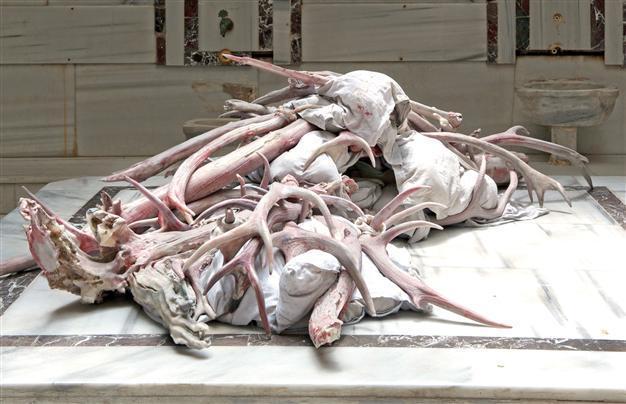The wound reveals life in De Bruyckere’s solo show
ISTANBUL- Hürriyet Daily News
 When Berlinde De Bruyckere came to Istanbul three years ago, she was looking for a subject to create new works for her solo show at Arter – Space for Art. Finally, she found a book by a surgeon who photographed women he had operated on at the end of the 1800s. The women had had cervical cancer, and the surgeon had removed their ovaries.
When Berlinde De Bruyckere came to Istanbul three years ago, she was looking for a subject to create new works for her solo show at Arter – Space for Art. Finally, she found a book by a surgeon who photographed women he had operated on at the end of the 1800s. The women had had cervical cancer, and the surgeon had removed their ovaries. The women in the photographs are dressed with only their stomachs exposed to show their surgical scars. “I found the book in a personal library in Istanbul, and when I saw the photos I decided to focus my works on this subject,” she said.
So De Bruyckere, a Belgian artist, decided that her starting point should be the women and their wounds. Her current exhibition at Arter, called “The Wound,” opens today and will continue until Aug. 26, revealing her new works, as well as some of her famous sculptures. The new works include “-009-, 2011-2012” and a new series also titled “The Wound.”
Displaying at Çukurcuma Hamam
As part of the exhibition, two new works by De Bruyckere will also be presented at the Çukurcuma Hamam. This space was included as an exhibition venue at the request of the artist, who wished to engage her work in a dialogue with the local context and architectural heritage. This additional exhibition site also refers to the idea of cleansing the body and rubbing off an extra layer of skin which, in a sense, implies molting.
In fact De Bruyckere’s works have something “alive” or “lively” in them even though they may seem to be pure “flesh.” The artist prefers to use her sculptures as objects that reflect a mental stage. The mental states in the images are finely reflected as metaphors in her works. For example, her works titled “Lost II” and “Lost III” from 2007 and 2008, respectively, once again showcase how she uses metaphors very boldly in her works.
The works reveal a commentary on World War I and were exhibited at the In Flanders Fields Museum, Ypres. “I have done research on World War I and in every book I saw, I saw horses on the street. I could not explain the feelings of loss and anger in a human body.”
As a result, De Bruyckere has chosen to use horses as a metaphor about the war. “Horses were huge and impressive, so I thought that this would be the motif that I should use. Immediately after this installation I felt that there was much more to do with the motif of the horse.”
De Bruyckere thought that this should not be only in relation to World War I. “Now more than 10 years [later], I feel that the horse has nothing to do with the world war,” she said, noting that because she gave them human emotions as an artist, the horses she has portrayed have become more human over time.
But De Bruyckere also used horses because it is a unique and proud animal. “If you look at some sculptures, you will see sculptures of men or women on horses” as horses symbolize power and pride, she said.The magical thing about horses is that they are a part of history yet still exist today, she said, adding that they did not change.
Horses as a metaphor
De Bruyckere continued the metaphor of horses in her newly created “The Wound” series. This time, instead of using horse figures, De Bruyckere uses horse headgear around the “wounds.”
For De Bruyckere, seeing the women in the surgeon’s book, all covered with only the belly part open, made a huge impact on her. “They had to stand there and show their bellies, which maybe the most private part of their bodies.”
This made her think about the wounds that the women had on their bellies. “So I created the wound, and wound is like a large vagina and also refers to those women’s surgeries. And then I came up to the horse metaphor and decided to use headgear around those wounds,” De Bruyckere said.
“I had used blankets as ‘protection’ in my works or to refer to a comfort zone,” she said, adding that this time, instead of blankets, she used horses’ headgear.
De Bruyckere’s objects and history
The usage of old materials and furniture reveals the close relationship between De Bruyckere’s works and history. The sculptures lying on old furniture may remind the audiences that the mental state, feelings and objects that existed in history are still present.
















